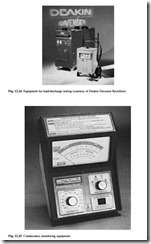Battery monitoring
The monitoring of battery condition is becoming more important as remote operation and reduced maintenance requirements are increasingly specified in standby power systems. The options which are available are summarized in the following sections.
Load-discharge testing
The basis of this test is to discharge the battery into a selected load for a preset time, after which the battery voltage is checked. In the majority of cases this will require that the battery is taken off line. The load-discharge test is very reliable, but it requires a special resistance load bank, and it is labour-intensive and time-consuming. Figure 12.24 shows an example of the type of equipment that is required.
dV /dt-load testing
The technique here is to connect a fixed known load to the battery for a short period and record the battery voltage over this period. By comparing the recorded load volt- age with data from the battery manufacturer, estimations can be made regarding the condition of the battery and its ability to perform.
Computer monitoring of cell voltages
In this case, measurement leads are taken from each cell to a central monitoring computer. The voltage of each cell is recorded through charge and discharge of the battery. Although cell voltage is not a direct indication of residual capacity, trends can be observed and weak cells can be identified.
Conductance monitoring
This method has increased in popularity in recent years and several manufacturers now offer a standard monitoring product based upon the technique. Figure 12.25 shows typical equipment. Monitoring the conductance of individual cells over their working life can give an indication of impending failure, allowing preventive maintenance to be
carried out. A particular advantage is that the readings can be reliably used whatever be the state of the charge of the battery.


